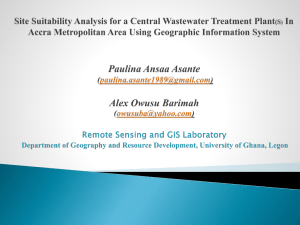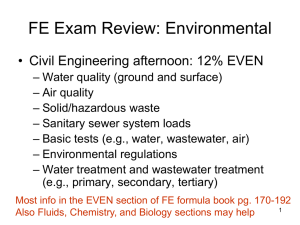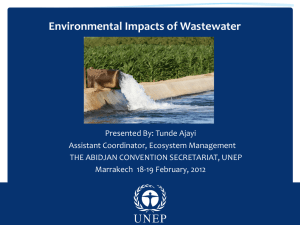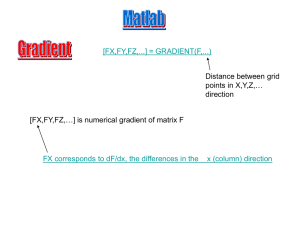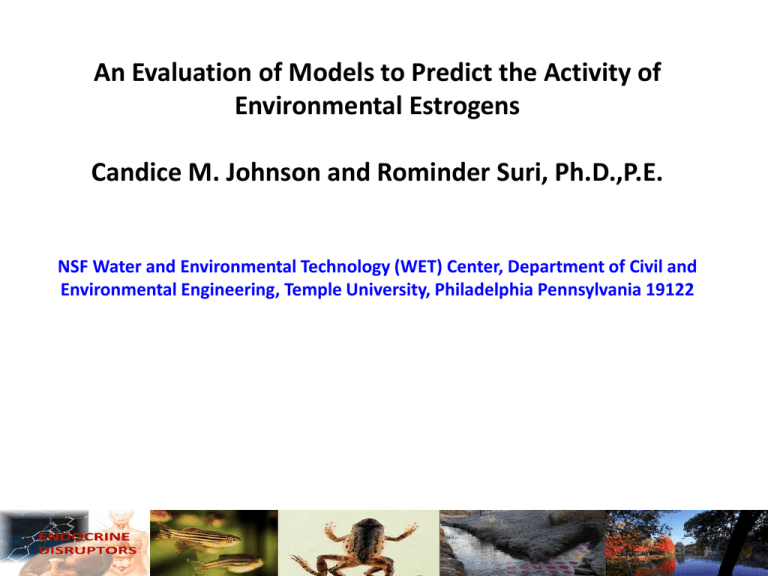
An Evaluation of Models to Predict the Activity of
Environmental Estrogens
Candice M. Johnson and Rominder Suri, Ph.D.,P.E.
NSF Water and Environmental Technology (WET) Center, Department of Civil and
Environmental Engineering, Temple University, Philadelphia Pennsylvania 19122
1
2
Endocrine Disrupting effects observed in the environment
• Imposex condition in snails
• Masculanization/Feminization of fish
• Altered sex ratio
Normal female
http://www.asnailsodyssey.com/LEARNABOUT/WHELK/whelImpo.php
Masculanized female
Normal male
• Increased risk of cancer in humans?
3
Natural &
Synthetic
Hormones
Pharmaceuticals
& Personal Care
Products
Endocrine
Disruptors
Pesticides
Herbicides
Fungicides
Industrial
Chemicals
4
Routes of entry for endocrine disruptors
in the environment
Manufacturing
Human
Use
Agriculture
Pretreatment
Water
treatment
plant
Effluent
Surface
Water
Biota
5
Endocrine disrupting activity is
related to wastewater treatment
Relative distance from water treatment plant
6
Removal of EDCs
End-of-Pipe Technologies
• Ozonation, Ultrasound, Adsorbents
Source Control Strategies
•
•
•
•
Risk assessment & hazard characterization
Development of policy and laws
Research and development of safer products
Replacement of endocrine active ingredients
7
Methods for detecting potential endocrine
disruptors
•
-
Chemical Analysis
target analysis
low limits of detection
rapid analysis methods
high throughput
no indication of biological activity
•
-
Biological Analysis (Bioassays)
detects the activity of mixtures and unknowns
detects interactions, measures net biological activity
does not indicate the identity or concentrations of specific
contaminants
8
Approaches to testing EDCs
1. Chemical-by- chemical approach
May be too simplistic and may underestimate the risks of
chemicals
2. Test mixture toxicity on a case by case basis
Chemical mixtures vary with respect to constituents and to
concentrations of those constituents, Provides site specific data
Band-Aid but not a cure to the characterization of chemical
mixtures (LeBlanc & Olmstead, 2004)
3. Component-based approach (estimating the total toxicity from
information on identified components)
A step towards a generalized understanding and assessment of
mixture toxicity
Effect Directed Analysis (EDA) scheme
Bioassay Screening
Antagonistic
activity?
-
-
LC-MS or GC-MS analysis
of target compounds
Chem Bio
Mathematical models are used to estimate the biological
effects from the concentration of target compounds
10
(confirmation)
extraction and pre-concentration
Correlation and quantification of casual factors
Unknown Environmental Samples
Additive models
Concentration addition (CA) model
RP C
n
n
IEQmix
RP = Relative Potential
Cn = Concentration of Component n in the mixture
IEQ = Induction equivalents in terms of a standard
Independent action (IA) model (probabilistic
model)
Emix = Predicted effect of the mixture
E mix
Fi (c i ) Emax = Maximum effect
E max1 1
Fi,(ci) = activating effects determined from the
E max regression of the concentration response
relationships
11
CA versus IA
Concentration Addition (CA)
• Applied to chemicals with a similar mode of action
• EC50 of a mixture can be predicted based on the EC50 values of the
individual components
Independent action (IA)
• Applied to chemicals with diverse modes of action
• Mixture effects predicted from precise effects of each individual
component and at the concentration found in the mixture. This
information is not readily available
• Assumes strictly independent events, may not be relevant in
biological systems due to converging signalling pathways and
inter-linked subsystems
Objective: To assess the ability of additive
models to predict estrogenic activity
Approach
1.Extract hormones from wastewater influent and
effluent samples
2.Measure the estrogenic activity of the extracts
using the Yeast Estrogen Screen (YES) Assay
3.Quantify the concentrations of suspected
estrogens using LC-MS/MS
4.Estimate the estrogenicity of the extracts using
additive models
13
Assessment of additive models
Table 1: Concentrations of hormones detected in wastewater
extracts
-1
Influent (ngL )
-1
Effluent (ngL )
*LOD
Estriol
17β-estradiol
Estrone
17αdihydroequilin
8.66
5.07
0.15
679.18
6.55
*<LOD
0.65
311.61
17β-estradiol = 0.15 ngL-1
Table 2: Total estrogenic activity of the wastewater extracts
measured in the YES
Effect Level Influent EEQ,
(%)
μg/L
50
0.0193
Effluent EEQ,
μg/L
0.00751
% Reduction
61.1
14
Assessment of additive models
Predicted and observed concentration response curves in the YES
Antagonistic- like activity is evident in both the wastewater influent
and effluent samples
15
Assessment of additive models in ‘clean’ water
Predictions based on simulated
samples do not suggest that the
mixture should be interactive
Clear contribution from the
wastewater matrix
Comparison of predicted and observed mixture responses for 17βestradiol, estriol, estrone, and 17α-dihydroequilin in simulated
sample
16
Assessment of additive models for estimating
estrogenicity and androgenicity
26%
Successful use
of CA
58%
Biological Interaction
with unknown
mixture components
17
Conclusions and Recommendations
• Incomplete degradation of estrogen hormones during
wastewater treatment
- 24 - > 99% removal of steroid hormones from this
wastewater treatment plant. Similar results were reported by
Chimchirian et al., 2007
• Residual estrogenicity after water treatment may lead to
endocrine disrupting effects in fish
- Suggested no effect concentration for 17β-estradiol is 2ngL-1 (Caldwell
et al., 2012)
- Estrogenicity of effluent in our study is 7ngL-1 EEQ
• No synergism or antagonism between estrogen hormones in
“clean” water
18
Conclusions and Recommendations
• Other unknown components in the wastewater
matrix may cause antagonistic responses
• Additive models are applicable to “clean” water
but may be limited in their use with complex
mixtures
• More advanced models that can capture
interactions or antagonistic effects are needed
19
n
1
CS X,
n RPX, n Cn EC X , S IEQ
n1
Testosterone
(μg/L)
2
2
2
2
2
2
2
2
2
2
2
2
aR
Cn- concentration of nth mixture component
γ - interaction index
RP - relative potential
IEQ - Induction equivalent concentrations
BPA
bR
DBP
aRPBPA
aRPDBP
0
40
80
160
320
640
1280
1875
2560
3750
5120
7500
0
5000
5000
5000
5000
5000
5000
10000
5000
10000
5000
10000
-2.61E-04
-2.58E-04
-2.55E-04
-2.50E-04
-2.40E-04
-2.22E-04
-1.88E-04
-1.62E-04
-1.36E-04
-1.01E-04
-7.13E-05
-3.91E-05
-5.37E-05
-5.37E-05
-5.37E-05
-5.37E-05
-5.37E-05
-5.37E-05
-5.37E-05
-5.37E-05
-5.37E-05
-5.37E-05
-5.37E-05
-5.37E-05
TEQ(μg/L) TEQ(μg/L) TEQ(μg/L)
CA Model Interaction Observed
(% Error)
Model
(% Error)
2 (0.1)
2.000 (0.1)
1.999
2 (39)
1.437 (0.4)
1.443
2 (35)
1.411(5.1)
1.487
2 (46)
1.362 (0.3)
1.367
*2 (53) 1.270 (3.0)
1.31
*2 (50)
1.109 (17)
1.333
*2 (53)
0.869 (33)
1.305
*2 (433) *0.186 (50)
0.375
*2 (96)
0.625 (39)
1.024
*2 (748) *0.039 (83)
0.236
*2 (133) 0.630 (27)
0.858
*2 (534)
0.289 (8)
0.417
* p<0.01 (These predictions are significantly different from the observed values)
a – concentration ratio of BPA to testosterone
Johnson, C.M., et al., Environmental
b – concentration ratio of DBP to testosterone
Science and Technology. 2013
TEQ – Testosterone equivalents
20
17β-E2 (µgL1)
E3
(µgL-1)
17α- EQN
(µgL-1)
(µgL-1)
0.0625
0.0625
0.0625
0.0625
0.0625
0
0
0
0
0
0.0313
0.0313
0.0313
0.0313
0.0313
0.0313
0.0313
0.0313
0.0313
0.0313
6.25
6.25
6.25
6.25
6.25
6.25
6.25
6.25
0
0
6.25
3.125
1.563
0.781
0.391
6.25
6.25
6.25
6.25
6.25
0.5
0.5
0.5
0.5
0.5
0.5
0.5
0
4
4
0.5
0.5
0.5
0.5
0.5
0.5
0.25
0.125
0.0625
0.0313
1200
600
300
150
75
600
300
300
1200
600
600
600
600
600
600
1200
600
300
150
75
aDBP
EEQ (μg/L)
CA Model
(% Error)
EEQ (μg/L)
Interaction
Model
(% Error)
*0.1219 (123) 0.0473 (13)
*0.1219 (59)
0.0878 (14)
0.1219 (34)
0.1080 (18)
0.1219 (9)
0.1181 (6)
0.1219 (6)
0.1231 (5)
*0.0594 (77)
0.0253 (25)
*0.0594 (50)
0.0455 (15)
*0.0362 (68)
0.0200 (7)
0.1858 (38)
0.1229 (9)
0.1858 (27)
0.1633 (12)
0.0907 (50)
0.0565 (6.8)
*0.0726 (51)
0.0364 (24)
*0.0635 (44) *0.0263 (40)
*0.0590 (42) *0.0213 (49)
*0.0567 (54) *0.0188 (49)
*0.0907 (136) *0.0161 (58)
*0.0791 (92)
0.0438 (6)
*0.0733 (67) *0.0576 (31)
*0.0703 (64) *0.0645 (50)
0.0689 (48)
0.0680 (46)
EEQ (μg/L)
Observed
0.0546
0.0765
0.0913
0.1118
0.1292
0.0335
0.0396
0.0216
0.1349
0.1459
0.0607
0.0481
0.0441
0.0416
0.0368
0.0384
0.0413
0.0439
0.043
21
0.0467
Thank you!
Questions?







